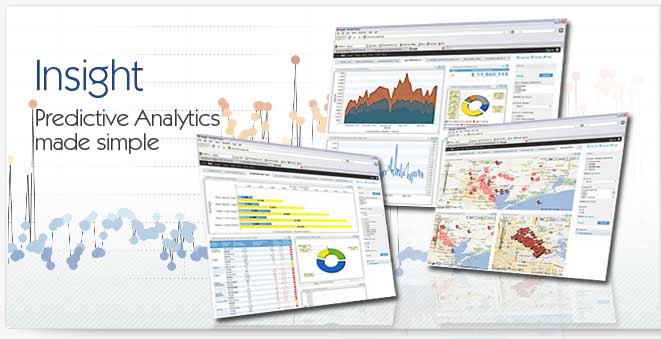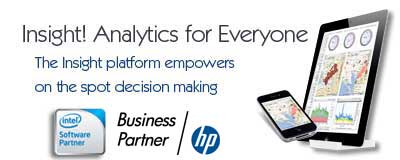The Revolution of Dashboard Software
The term "Dashboard Software" might conjure up any number of possible devices and setups. In the business community, however, dashboard software is almost universally used to describe a collection of reports and interactive charts that provide business information to aid in the day-to-day (tactical) or long-term (strategic) planning of the business. Dashboard software is not a new concept and solutions have been widely available for a number of years. Over the course of the past five years, however, a radical shift in how dashboard software is used - and how it's deployed - is helping bring the power and benefits of this technology to a significantly broader audience.
The Power of Dashboard Software
Before we can dive into the ground-breaking changes that are altering the dashboard software industry, we must first understand the power of dashboard software and its reason for being. In order to understand dashboard software one must first understand the very nature of business management. As companies grow and flourish it quickly becomes difficult, and eventually impossible, to keep track of the critical measurements of business performance that are key indicators of the health of the organization. Dashboard software then, provides a vital "heads up display" for business managers, allowing them to leverage the copious amounts of data created and stored by their business to make better decisions. Using dashboard software a sales organization can better track sales measurements like order close rates, lead conversion rates, lead sources and, of course, performance by sales rep. Similarly, other departments in the business can create customized daily, weekly, monthly and yearly dashboards to help track measurements of company performance at both the tactical level (how many widgets did we sell this month) and a strategic one (is our market share growing outside the US).
Dashboard Software, The Enemy
While dashboard software provides a number of huge benefits to any organization, there are a number of drawbacks to using dashboard software that have, until very recently, limited its adoption to the elite of the business community: the "enterprise" companies whose massive budgets and armies of IT staff were able to install, manage and use dashboard software effectively. The reasons behind this lack of adoption outside of large businesses has largely been due to three major obstacles to the wide adoption of dashboard software: First, dashboard software is hard to install. Historically installing dashboard software has meant navigating from desktop to desktop and installing dedicated software for each user. This of course means that as the software is updated the lengthy and time-consuming task must be repeated each time. Second, dashboard software has traditionally relied on one simple hypothesis: The companies buying the software have ample IT resources. This basically means that traditional dashboard software companies have always assumed that their customer would have a lot of staff whose only job would be to create reports, distribute them and update them. This has meant that dashboard software was often designed with the needs of the technically savvy person in mind as the "creator" and the business user as a simple "consumer" of information. Finally, dashboard software has traditionally required the use of expensive and massive "data warehouses" to collect, filter, aggregate and prepare the various data that the business needed to track.
Dashboard Software Revolution Part 1: BI Anywhere
First, a bit about terminology. When we refer to "dashboard software" we are typically referring to a product that is also often associated with the category of business intelligence - or "BI". BI Anywhere is a term that describes a new form of dashboard software platform that makes it simple and easy for users - regardless of role - to access their dashboarding environment wherever they may be, whenever they may need it. To accomplish this, new pioneering dashboard software companies have leveraged the power of the Internet browser and the mobile device revolution to create a set of platforms that can be installed on a server and is then available to employees across the entire business through a simple Internet browser. Because 100% of the operations possible on the platform are accomplished through the browser, employees can access their dashboard software at work, on the road, at home -and from just about any device - thereby eliminating the cost and labor associated with deploying local applications and managing them.
Part 2 of the Dashboard Software Revolution: The Business User is in Charge
Next up in the challenge to "democratize" dashboard software is changing the perspective of who is "in charge." With traditional dashboard software "consumers" of information were always clients - people who asked for reports, waited for an "expert" to perform some magic and then delivered the stunning results to the user. This model was effective and easily replicated given two conditions: lots of IT people with time to write reports and decisions that were made in weeks and months, which gave the IT staff ample time to complete reports and dashboards. As the world has changed, however, the pace of business has accelerated. Decisions that were once made in months are now made in weeks and what ten years ago could be done in days is now required in one hour. With the increasing rate of decision-making and the ease with which companies can go from being "king" to being the also-ran, business users are demanding the ability to access reports quickly and accurately. This means that modern dashboard software changes the roles and puts the user in charge of the dashboard, while still relying on the expertise of the IT department to attach to data sources and to provide the data to the business users - who are now themselves the report writers. This means that your director of sales can now long into an easy to use system and with 100% drag-and-drop operations create a quarterly sales report in minutes - rather than having to wait for days to have a report created for him.
Dashboard Software Revolution, Part 3: What Warehouse?
The revolution of dashboard software, however, doesn't stop at the desk of the business user. In order to create an environment that stimulates what is known as 'self-service', the ability for business users to create reports and dashboards themselves, help must be brought to bear to the IT staff as well. This is where dashboard software brings new models of data management that are designed to minimize and often eliminate the need for complex data manipulations and aggregations that were needed to perform analysis. Once again, because of the ever changing nature of the business world, organizations are having to adapt. A typical business today generates more data in a single day than the largest of enterprises created in a year less than ten years ago. With these massive amounts of data businesses need a faster, easier way of attaching to the multitude of data sources available to prepare them for reporting by business users. Modern dashboard software provides some of these tools and has begun the process of making data management just as easy as it has made report generation.
Dashboard Software, Easy as Pie?
The long-term outlook for dashboard software is very good. New tools are coming to the market that provide revolutionary ease of use and have completely changed the way businesses use and leverage data. Dashboard software, however, is still far from "easy." The underlying complexity of data, the systems that dashboard software must attach to, and the nature of business reporting itself still mean that for dashboard software to be successful the role of the "expert" is safe and sound. The expert, however, is changing in responsibility. Gone are the days when "BI experts" were responsible for every single aspect of a dashboard software implementation, instead they are being replaced by specialists whose primary responsibility is the management of "data" and ensuring the high availability of clean, reliable and accurate information to users on a business-wide basis. In order for dashboard software to make the next "leap" the next frontier will be making these people's jobs easier and more effective.
|



